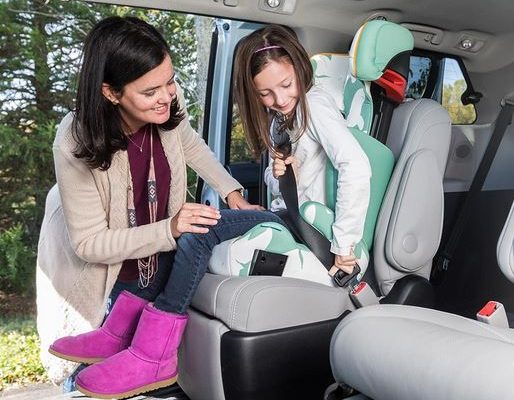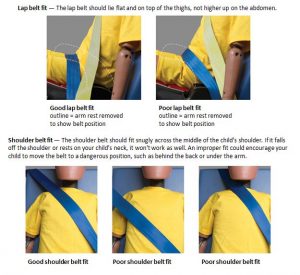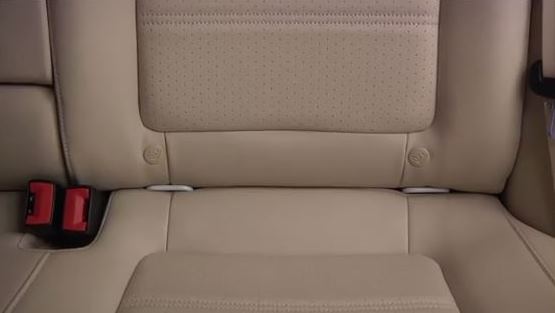Tag Archive: IIHS

IIHS: List Of Top Child Booster Seats for 2016
November 18, 2016
If you’re a parent whose child is ready to graduate to a booster seat or a grandparent looking for the perfect Christmas gift to ensure your grandchild’s safety, the Insurance Institute for Highway Safety (IIHS) has come out with a new list of the top booster seats just in time for the Christmas shopping season
It seems that manufacturers have gotten the hint and, compared to only 25% of the seats getting a good rating in 2008, this year, 48 out of 53 new models got a best bet rating. A best bet rating means they are likely to provide good belt fit for a four to eight year old child in almost any car, minivan, or SUV.
Out of the 53 seat models tested, three seats are rated “Check Fit” meaning they may not provide the best belt fit in all makes of vehicles. Two seats, the Cosco Easy Elite and the Cosco Highback 2-in-1 DX — both made by Dorel — were rated “Not Recommended.”

Click on image to enlarge
Parents should remember that, in spite of some state laws, booster seats are recommended for children once they outgrow their child seat, at approximately age four, until they’re big enough for a seat belt to fit properly, low on their hips, without riding up over their abdomen. For the average child that can be anywhere from nine to twelve years of age.
Another thing to remember is that child seats have an expiration date. Sunshine and trapped heat inside a car over long periods of time can degrade the plastics and synthetic fabrics used in the seat structure and belts. If you’re considering using a hand-me-down seat, you’ll want to check the expiration date located underneath the seat.
For more information, visit: Designs that click – Booster manufacturers have mastered good belt fit
Images courtesy: Insurance Institute for Highway Safety

IIHS Rates Child Safety Seat LATCH Mechanisms
June 25, 2015
The Insurance Institute for Highway Safety (IIHS) has come out with a rating list of child safety seat LATCH mechanisms. LATCH (Lower Anchors and Tethers for Children) systems, which have been required equipment on passenger vehicles since 2002, are supposed to make it easier for parents and caregivers to safely install child safety seats. In this first review of LATCH system ease of use, few cars made the grade.
LATCH systems consist of anchor points low on the seat and tether points on the back of the seat. Research shows that child seats installed with LATCH, rather than with vehicle seat belts, are more likely to be installed correctly. Whether or not parents use LATCH correctly depends on the attachment point’s visibility and ease of access.
According to an American Academy of Pediatrics study in 2014, 93 percent of new parents taking their newborn home from the hospital for the first time made at least one critical error in placing or attaching their infant car seat. LATCH systems are supposed to make that process easier but, according to the IIHS, most cars LATCH systems are difficult to find or are difficult to reach making it more difficult to attach car seats.
In conducting their study, the IIHS looked at five different criteria for a vehicle to receive a “good” rating:
- The lower anchors are no more than 3/4 inch deep in the seat bight.
- The lower anchors are easy to maneuver around. This is defined as having a clearance angle greater than 54 degrees.
- The force required to attach a standardized tool to the lower anchors is less than 40 pounds. (The tool represents a lower connector of a child seat, though the actual force required when installing a seat varies depending on the specific connector.)
- Tether anchors are on the vehicle’s rear deck or on the top 85 percent of the seatback. They shouldn’t be at the very bottom of the seatback, under the seat, on the ceiling or on the floor.
- The area where the tether anchor is found doesn’t have any other hardware that could be confused for the tether anchor. If other hardware is present, then the tether anchor must have a clear label located within 3 inches of it.
According to the IIHS, out of 102 models tested, only three models received a good rating; they are:
- BMW 5 series
- Mercedes-Benz GL-Class
- Volkswagen Passat
Out of the rest of the models tested, 44 were acceptable, 45 were marginal, and 10 were rated poor.
To read more and to view all of the models and their LATCH ease of use ratings, visit: IIHS launches ease-of-use ratings of LATCH hardware in vehicles
For information on choosing and installing the right car seat for your child, visit: Parents Central
